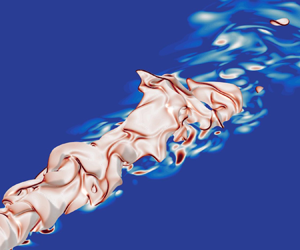Crossref Citations
This article has been cited by the following publications. This list is generated based on data provided by
Crossref.
Jiang, Bin
Brouzet, Davy
Talei, Mohsen
Gordon, Robert L.
Cazeres, Quentin
and
Cuenot, Benedicte
2021.
Turbulent flame-wall interactions for flames diluted by hot combustion products.
Combustion and Flame,
Vol. 230,
Issue. ,
p.
111432.
Palulli, Rahul
Brouzet, Davy
Talei, Mohsen
and
Gordon, Robert
2021.
A comparative study of flame-wall interaction and flame-cooling air interaction.
International Journal of Heat and Fluid Flow,
Vol. 92,
Issue. ,
p.
108888.
Garcia, Alex M.
Le Bras, Sophie
Prager, Jens
Häringer, Matthias
and
Polifke, Wolfgang
2022.
Large eddy simulation of the dynamics of lean premixed flames using global reaction mechanisms calibrated for CH4–H2 fuel blends.
Physics of Fluids,
Vol. 34,
Issue. 9,
Gupta, Shreshtha K.
Palulli, Rahul
Talei, Mohsen
Gordon, Robert L.
and
Arghode, Vaibhav K.
2022.
CO modelling of premixed head-on quenching flame in the context of Large-Eddy Simulation.
International Journal of Heat and Fluid Flow,
Vol. 93,
Issue. ,
p.
108895.
Panek, Pavel
Brouzet, Davy
Talei, Mohsen
and
Gordon, Robert L.
2022.
A priori assessment of flame surface density modelling for large-eddy simulation of sound generation by turbulent premixed flames.
Combustion and Flame,
Vol. 241,
Issue. ,
p.
112143.
Ho, Jen Zen
Jella, Sandeep
Talei, Mohsen
Bourque, Gilles
Indlekofer, Thomas
and
Dawson, James
2023.
Assessment of the LES-FGM framework for capturing stable and unstable modes in a hydrogen / methane fuelled premixed combustor.
Combustion and Flame,
Vol. 255,
Issue. ,
p.
112904.
Chen, Rongqian
Cao, Shuqi
Liu, Wanhong
Song, Qiaochu
and
You, Yancheng
2023.
Acoustic multipole source–simplified lattice Boltzmann method for simulating acoustic propagation problems.
International Journal for Numerical Methods in Fluids,
Vol. 95,
Issue. 7,
p.
1174.
Dou, Xinbei
Talei, Mohsen
and
Yang, Yi
2023.
Analysis of pressure oscillations and wall heat flux due to hydrogen auto-ignition in a confined domain.
Physics of Fluids,
Vol. 35,
Issue. 1,
Rodríguez-Gutiérrez, David
Gómez-Miguel, Raquel
Fernández-Tarrazo, Eduardo
and
Sánchez-Sanz, Mario
2023.
Characterization of symmetric to non-symmetric flamefront transition in slender microchannels.
Proceedings of the Combustion Institute,
Vol. 39,
Issue. 2,
p.
1813.
Ho, Jen Zen
Talei, Mohsen
and
Gordon, Robert L.
2024.
Direct numerical simulation of stoichiometric hydrogen/methane premixed jet flames.
International Journal of Hydrogen Energy,
Vol. 81,
Issue. ,
p.
831.
Ho, Jen Zen
Talei, Mohsen
Brouzet, Davy
Chung, Wai Tong
Sharma, Pushan
and
Ihme, Matthias
2024.
Augmenting filtered flame front displacement models for LES using machine learning with a posteriori simulations.
Proceedings of the Combustion Institute,
Vol. 40,
Issue. 1-4,
p.
105311.
Piu, Lorenzo
Péquin, Arthur
Freitas, Rodolfo S. M.
Iavarone, Salvatore
Pitsch, Heinz
and
Parente, Alessandro
2025.
A Data-Driven Approach to Refine the Partially Stirred Reactor Closure for Turbulent Premixed Flames.
Flow, Turbulence and Combustion,
